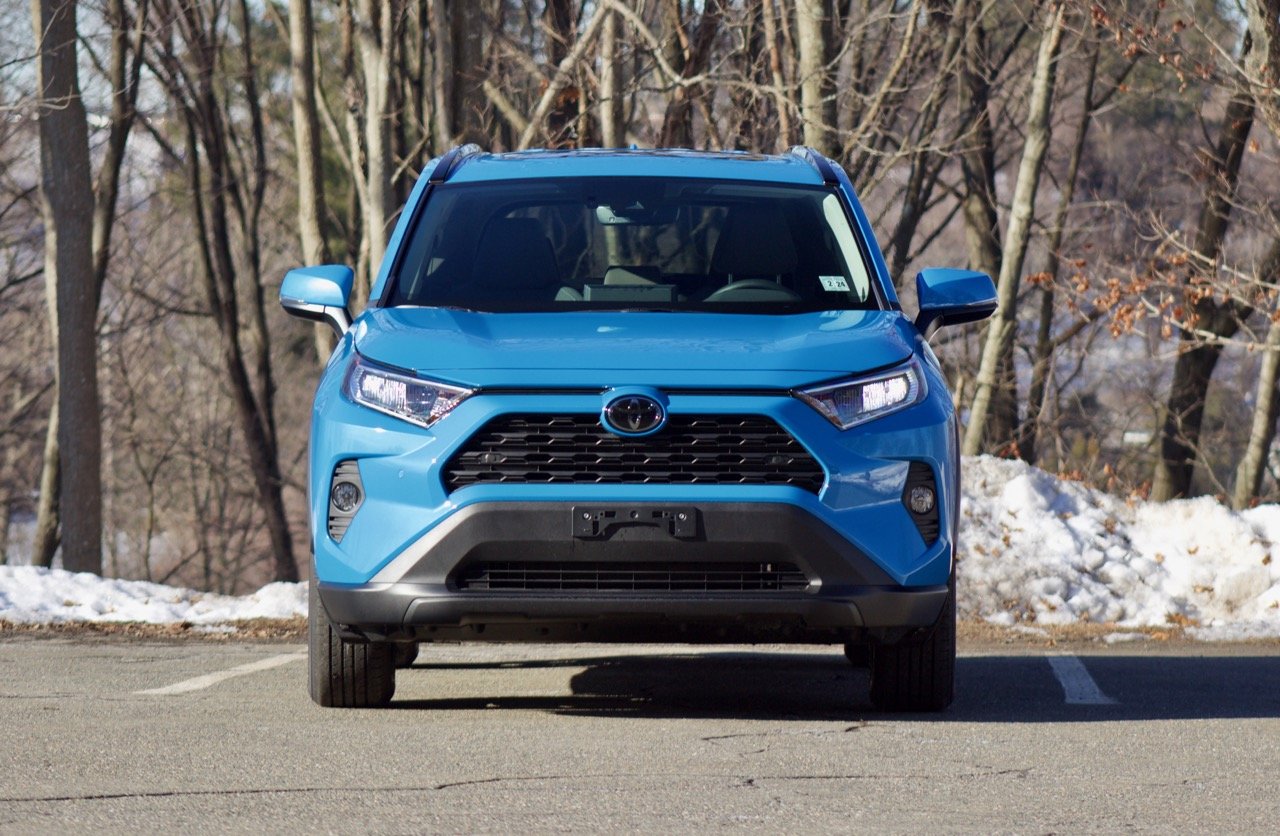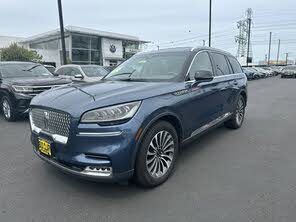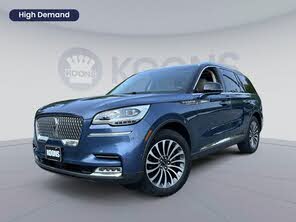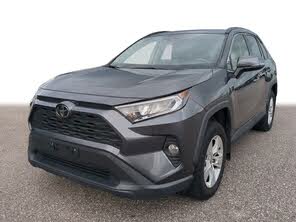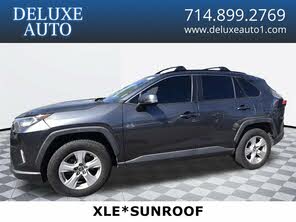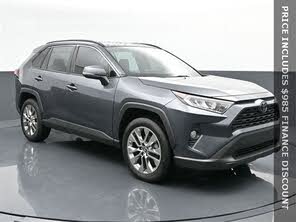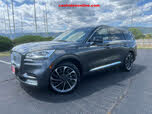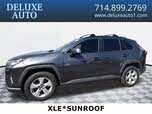2020 Lincoln Aviator vs 2019 Toyota RAV4
CarGurus highlights
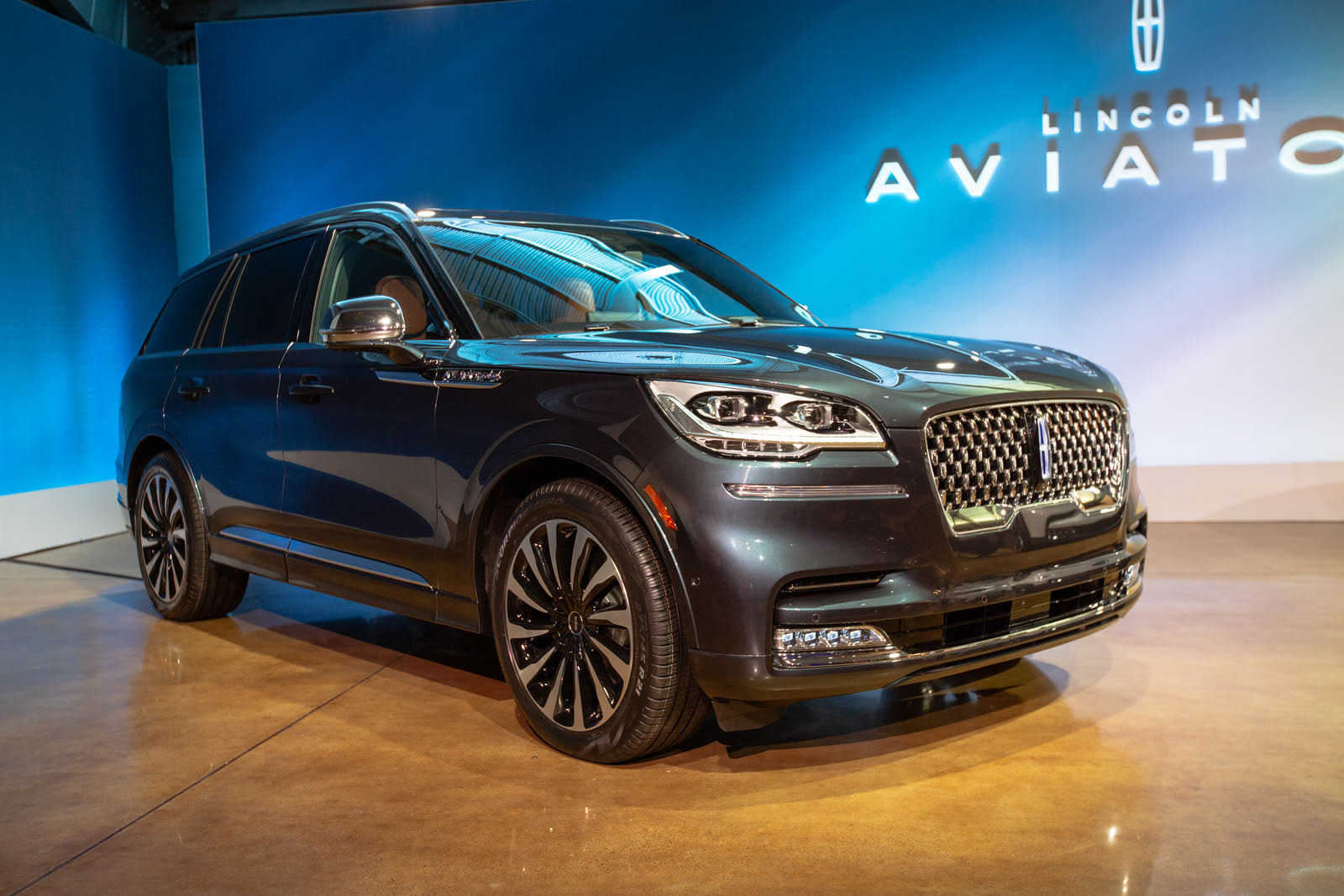
According to CarGurus experts, the overall rating for 2019 Toyota RAV4 is 8.0 out of 10, while the 2020 Lincoln Aviator scores slightly higher at 8.2 out of 10. With this in mind, the Lincoln Aviator edges out as the recommended choice for those seeking luxury, advanced technology, and powerful performance. The RAV4, while excellent in fuel efficiency and capability, falls short in comparison. Thus, for an all-around superior experience, the 2020 Lincoln Aviator stands as the more compelling choice.
Choose the 2020 Lincoln Aviator if:
- You desire a luxurious, high-tech SUV with powerful performance options.
- You need ample cargo space and comfortable seating for family trips.
- You appreciate high-end touches like a massive sunroof and a fully digital instrument panel.
Choose the 2019 Toyota RAV4 if:
- You prioritize fuel efficiency and decent cargo capacity in a compact SUV.
- You need an SUV with genuine off-road capabilities.
- You prefer a simpler, more intuitive infotainment system.
Overview | |
MSRP$25,650 | MSRP$51,100 |
Average price$24,413 | Average price$36,770 |
Listings1495 | Listings531 |
Ratings & Reviews | |
User Reviews | User Reviews |
Expert reviews8.0 out of 10 | Expert reviews8.2 out of 10 |
Pros
| Pros
|
2019 Toyota RAV4 Reviews SummaryThere’s a reason small SUVs like the 2019 Toyota RAV4 are among the most popular vehicles on the new car market. Consider the RAV4 and its rivals, the Honda CR-V, Mazda CX-5, and Ford Escape—what do they have in common? To put it simply, these vehicles are asked to do it all. Daily commuter car? Check. Family-hauler to school, practice, and the mall? Check, check, and check. Road-trip vehicle? Yeah, that too. On top of it all, these vehicles have to be affordable, efficient, and reliable. Sales of traditional sedans have been dwindling, but if sedans could do as much as crossovers can, they would still be popular vehicles. The RAV4 is one of the oldest vehicles in the segment, and its story tells us how these small SUVs became so popular. The previous RAV4 was an extremely competent vehicle for Toyota, covering all the things we ask of compact SUVs. But the new 2020 RAV4 goes a few steps further. It has standout Tonka-truck styling, a surprisingly upscale interior, and something that it had lost since debuting more than two decades ago: a bit of off-road ability. We’ll see whether this makes it better than the RAV4 it replaces, and if it allows the 2020 RAV4 to stand out in a crowded small SUV market. | |
2020 Lincoln Aviator Reviews SummaryThe heyday for Lincoln was more than a half-century ago. Those postwar years of prosperity and optimism were the perfect time for cars like the Continental and others. They delivered comfort and luxury, wrapped in midcentury modern styling. Even as recently as the 1990s, Lincoln was still a popular brand, riding the SUV craze with its Navigator. But after the turn of the century, Lincoln lost its ability to create new designs and looked inward and backward. Sure, retro-themed cars like the redesigned Mustang, PT Cruiser, and Chevy HHR had turned some heads, but none of those came from luxury brands. The BMWs and Mercedes of the world were all looking forward and pushing the envelope for contemporary automotive design. Meanwhile, Lincoln offered the MKX, which was based on the Ford Edge and featured ’66 Continental styling. Neat in a vacuum, but off-base compared to the modern luxury market. This experimental phase with various retro looks coincided with the move to the MK-# alphabet-soup naming convention and big improvements in the Ford lineup, where top-end trims of the Fusion overlapped with an entry-level trim of the MKZ. The combination left Lincoln a confusing, anonymous afterthought in the modern luxury game. But Lincoln is finally ready to change all that. It has a new cohesive design language, its focus is once again on luxury, and the three-letter naming convention that never meant anything to anyone other than Lincoln marketers is gone. The brand led with the 2017 Continental and 2018 Navigator, which are each impressive in their own right. But the company's lineup is growing and now includes the all-new 2020 Lincoln Aviator. Named after a luxury variant of the 2002-2005 Ford Explorer, this new Aviator is also based on the contemporary Explorer platform, but it's a luxury vehicle in its own right. Much of the success of the Lincoln brand may hinge on this midsize, 3-row luxury SUV, so you need to consider its competition, such as the Audi Q7, Infiniti QX60, and all-new Cadillac XT6. Read on to learn if Lincoln’s take on luxury will stand out in a crowded competitive field. | |
Popular Features & Specs | |
Engine2.5L 203 hp I4 | Engine3.0L 400 hp V6 |
Drive TrainFWD | Drive TrainRWD |
Seating Capacity5 | Seating Capacity7 |
Horsepower203 hp @ 6000 rpm | Horsepower |
MPG City26 | MPG City18 |
MPG Highway35 | MPG Highway26 |
Engine | |
Engine Name2.5L 203 hp I4 | Engine Name3.0L 400 hp V6 |
Torque184 lb-ft @ 5000 rpm | Torque |
Horsepower203 hp @ 6000 rpm | Horsepower |
DrivetrainFWD | DrivetrainRWD |
Fuel Economy | |
MPG City26 | MPG City18 |
MPG Highway35 | MPG Highway26 |
Interior | |
Seating Capacity5 | Seating Capacity7 |
Safety | |
Front Crash Overall4 | Front Crash Overall5 |
Side Crash Overall5 | Side Crash Overall5 |
Dimensions & Capacity | |
Cargo Space37.6 cu ft | Cargo Space18.3 cu ft |
Curb Weight3370 lbs | Curb Weight4764 lbs |
Height67.0 in | Height69.8 in |
Length180.9 in | Length199.3 in |
Width73.0 in | Width89.9 in |
Wheelbase105.9 in | Wheelbase119.1 in |
Maximum Payload1240 lbs | Maximum Payload |
Number of doors4 | Number of doors4 |
Maximum Towing Capacity1500 lbs | Maximum Towing Capacity |
CarGurus highlights

According to CarGurus experts, the overall rating for 2019 Toyota RAV4 is 8.0 out of 10, while the 2020 Lincoln Aviator scores slightly higher at 8.2 out of 10. With this in mind, the Lincoln Aviator edges out as the recommended choice for those seeking luxury, advanced technology, and powerful performance. The RAV4, while excellent in fuel efficiency and capability, falls short in comparison. Thus, for an all-around superior experience, the 2020 Lincoln Aviator stands as the more compelling choice.
Choose the 2020 Lincoln Aviator if:
Shop Now- You desire a luxurious, high-tech SUV with powerful performance options.
- You need ample cargo space and comfortable seating for family trips.
- You appreciate high-end touches like a massive sunroof and a fully digital instrument panel.
Choose the 2019 Toyota RAV4 if:
Shop Now- You prioritize fuel efficiency and decent cargo capacity in a compact SUV.
- You need an SUV with genuine off-road capabilities.
- You prefer a simpler, more intuitive infotainment system.
Overview | ||
MSRP | $25,650 | $51,100 |
Average price | $24,413 | $36,770 |
Listings | ||
Ratings & Reviews | ||
User reviews | 4.3 | 4.5 |
Expert reviews | 8.0 out of 10Read full review | 8.2 out of 10Read full review |
Pros & cons | Pros
| Pros
|
Summary | There’s a reason small SUVs like the 2019 Toyota RAV4 are among the most popular vehicles on the new car market. Consider the RAV4 and its rivals, the Honda CR-V, Mazda CX-5, and Ford Escape—what do they have in common? To put it simply, these vehicles are asked to do it all. Daily commuter car? Check. Family-hauler to school, practice, and the mall? Check, check, and check. Road-trip vehicle? Yeah, that too. On top of it all, these vehicles have to be affordable, efficient, and reliable. Sales of traditional sedans have been dwindling, but if sedans could do as much as crossovers can, they would still be popular vehicles. The RAV4 is one of the oldest vehicles in the segment, and its story tells us how these small SUVs became so popular. The previous RAV4 was an extremely competent vehicle for Toyota, covering all the things we ask of compact SUVs. But the new 2020 RAV4 goes a few steps further. It has standout Tonka-truck styling, a surprisingly upscale interior, and something that it had lost since debuting more than two decades ago: a bit of off-road ability. We’ll see whether this makes it better than the RAV4 it replaces, and if it allows the 2020 RAV4 to stand out in a crowded small SUV market. | The heyday for Lincoln was more than a half-century ago. Those postwar years of prosperity and optimism were the perfect time for cars like the Continental and others. They delivered comfort and luxury, wrapped in midcentury modern styling. Even as recently as the 1990s, Lincoln was still a popular brand, riding the SUV craze with its Navigator. But after the turn of the century, Lincoln lost its ability to create new designs and looked inward and backward. Sure, retro-themed cars like the redesigned Mustang, PT Cruiser, and Chevy HHR had turned some heads, but none of those came from luxury brands. The BMWs and Mercedes of the world were all looking forward and pushing the envelope for contemporary automotive design. Meanwhile, Lincoln offered the MKX, which was based on the Ford Edge and featured ’66 Continental styling. Neat in a vacuum, but off-base compared to the modern luxury market. This experimental phase with various retro looks coincided with the move to the MK-# alphabet-soup naming convention and big improvements in the Ford lineup, where top-end trims of the Fusion overlapped with an entry-level trim of the MKZ. The combination left Lincoln a confusing, anonymous afterthought in the modern luxury game. But Lincoln is finally ready to change all that. It has a new cohesive design language, its focus is once again on luxury, and the three-letter naming convention that never meant anything to anyone other than Lincoln marketers is gone. The brand led with the 2017 Continental and 2018 Navigator, which are each impressive in their own right. But the company's lineup is growing and now includes the all-new 2020 Lincoln Aviator. Named after a luxury variant of the 2002-2005 Ford Explorer, this new Aviator is also based on the contemporary Explorer platform, but it's a luxury vehicle in its own right. Much of the success of the Lincoln brand may hinge on this midsize, 3-row luxury SUV, so you need to consider its competition, such as the Audi Q7, Infiniti QX60, and all-new Cadillac XT6. Read on to learn if Lincoln’s take on luxury will stand out in a crowded competitive field. |
Video | ||
Popular Features & Specs | ||
Engine | 2.5L 203 hp I4 | 3.0L 400 hp V6 |
Drive Train | FWD | RWD |
Seating Capacity | 5 | 7 |
Horsepower | 203 hp @ 6000 rpm | |
MPG City | 26 | 18 |
MPG Highway | 35 | 26 |
Engine | ||
Engine Name | 2.5L 203 hp I4 | 3.0L 400 hp V6 |
Torque | 184 lb-ft @ 5000 rpm | |
Horsepower | 203 hp @ 6000 rpm | |
Drivetrain | FWD | RWD |
Fuel Economy | ||
MPG City | 26 | 18 |
MPG Highway | 35 | 26 |
Interior | ||
Seating Capacity | 5 | 7 |
Safety | ||
Front Crash Overall | 4 | 5 |
Side Crash Overall | 5 | 5 |
Dimensions & Capacity | ||
Cargo Space | 37.6 cu ft | 18.3 cu ft |
Curb Weight | 3370 lbs | 4764 lbs |
Height | 67.0 in | 69.8 in |
Length | 180.9 in | 199.3 in |
Width | 73.0 in | 89.9 in |
Wheelbase | 105.9 in | 119.1 in |
Maximum Payload | 1240 lbs | |
Number of doors | 4 | 4 |
Maximum Towing Capacity | 1500 lbs | |
The 2019 Toyota RAV4 presented a bold and aggressive design, immediately noticeable by its chunky build and sharp edges, which were strongly reminiscent of the Toyota Tacoma pickup. Its overall exterior style was futuristic and conveyed a sense of robustness, a theme consistent across the side profile and rear, where the taillights seemed inspired by Lexus, Toyota’s luxury brand.
A character line disrupted the rear C-pillar, a common but sometimes visually unappealing design trait. Almost half the available color options featured matching body and roof colors, but seven trims offered a contrasting roof. While this black strip in the rear pillar seemed logical for two-tone versions, it felt like unnecessary design clutter for single-tone options.
Inside, the RAV4 showcased a surprisingly simple and elegant cabin, counterbalancing the busy exterior. The floating touchscreen hosted most features, while remaining controls were neatly arranged into a centrally-placed “pod,” extending from the dash to the cupholders.
The RAV4 came in several trims: LE, XLE, XLE Premium, Adventure, and Limited. The base LE trim included standard features like steel 17-inch wheels with plastic covers, LED lighting, power side mirrors, low-profile black roof rails, and privacy-tinted windows. The XLE trim, which CarGurus recommended and tested, added 17-inch 5-spoke alloy wheels, automatic high beams, integrated fog lights, color-keyed mirrors with turn signals, a power moonroof, push-button start, sport bucket seats, and dual-zone climate control.
The XLE Premium trim upped the ante with 19-inch alloy wheels, a power liftgate, an 8-way power driver’s seat, a leather-wrapped steering wheel and shift lever, and SofTex leatherette seats. The Adventure trim took a rugged turn with unique 19-inch wheels, all-wheel drive, black fender cladding, upgraded roof rails, and orange interior accents. The range-topping Limited trim focused on upscale features, such as 19-inch chrome wheels, unique grille, puddle lights, chrome handles, brown interior accents, ambient lighting, and an array of optional luxury packages.
The 2020 Lincoln Aviator sat comfortably between the Navigator and the compact MKC (later replaced by the Corsair) in Lincoln's lineup. Its design was cohesive with Lincoln’s modern style, sporting handsome headlights and an upright chrome grille. The tapering roofline and low, wide beltline added to its elongated, almost boat-like appearance.
Inside, the Aviator featured a flowing design with abundant soft-touch materials and strategic brightwork. The substantial use of plush leather, extending from the dash to the door panels and center console, highlighted Lincoln’s commitment to luxury. The seats exuded elegance and comfort, with a piano-key design for the shifter buttons hinting at a touch of Golden Age luxury without overwhelming the overall design language.
The Aviator’s lineup offered five trims: Standard, Reserve, Grand Touring, Black Label, and Black Label Grand Touring. The base Standard trim was well-equipped with three-zone climate control, parking sensors, leather upholstery, heated front seats, and the Sync 3 infotainment system with Apple CarPlay, Android Auto, a WiFi hotspot, and USB ports. The Reserve trim added second-row captain's chairs, power-adjustable front seats, upgraded leather, a power liftgate, premium sound, quad-zone climate control, a surround-view camera, and navigation. The Grand Touring further enhanced these offerings with a hybrid drivetrain, massive sunroof, head-up display, and 30-way seats with massage. At the top, the Black Label trims boasted unique upholstery choices and almost every feature imaginable as standard.
The 2019 Toyota RAV4 was powered by a 2.5-liter 4-cylinder engine producing 203 horsepower and 184 pound-feet of torque, paired with an 8-speed automatic transmission. This powertrain drove either the front wheels or an optional all-wheel-drive system, available in two variants: a base AWD setup and a more advanced torque-vectoring AWD exclusive to the Adventure and Limited trims. The torque-vectoring AWD was capable of real-time power distribution to the wheels needing it most, enhancing off-road capabilities significantly.
During our test, the XLE trim featured the base AWD setup, providing Snow, Sand & Mud, and Rock & Dirt drive modes. Despite not having driven the torque-vectoring setup, its ability to distribute power seamlessly suggested improved off-road performance.
On-road, the 2.5-liter engine offered decent highway acceleration and satisfactory power for overtaking. However, in stop-and-go situations, it felt slightly underpowered, and engine noise was pronounced. Ride quality was generally good, comfortable with a few bumps, but the steering felt twitchy, and body roll was evident, particularly through fast corners. While the RAV4 had once shared driving dynamics akin to the Honda CR-V, that was no longer the case. Nonetheless, its off-road capabilities remained noteworthy in a segment largely devoid of such features.
Fuel economy was commendable, with the front-wheel-drive RAV4 achieving 26 mpg city, 35 highway, and 30 combined. The standard AWD version returned 27 mpg city and 34 highway, while the torque-vectoring AWD offered 25 mpg city, 33 highway, and 28 combined. Our real-world testing yielded a combined 29.3 mpg.
The standard Aviator boasted a twin-turbocharged 3.0-liter V6 engine, generating an impressive 400 horsepower and 415 pound-feet of torque. This engine was shared with other models in Ford's lineup and paired with a 10-speed automatic transmission, available with either rear-wheel drive (RWD) or all-wheel drive (AWD).
The Grand Touring trim took things up a notch with a plug-in hybrid (PHEV) drivetrain, coupling the 3.0-liter V6 with a 100-hp electric motor. This setup produced a combined 494 horsepower and 630 pound-feet of torque, offering significant power and efficiency. Both powertrains achieved a 0-60 mph sprint in about 4 seconds, showcasing the Aviator's robust performance.
The hybrid system in the Grand Touring used electric power at lower speeds, ensuring smooth and quiet acceleration, especially with the stop-start system. The Aviator's standard driving experience was characterized by light steering and cushioned brake feedback, evoking a sense of refined softness similar to high-end models like the Rolls-Royce Cullinan, albeit at a different tier.
Fuel economy varied, with the conventional RWD Aviator achieving 18 mpg city, 26 highway, and 21 combined. The AWD version returned slightly lower numbers with 17 mpg city, 24 highway, and 20 combined. The PHEV offered a combined 23 mpg, with a 21-mile electric-only range and a 56 miles-per-gallon equivalent.
The cabin of the RAV4 was designed to be clean and upscale while remaining highly practical. The center stack contained climate controls, a sizeable tray for essentials, drive-mode controls, and a compact shifter. Storage solutions were plentiful, with a deep center console bin and a passenger dash tray.
Cargo capacity was substantial, offering 37.6 cubic feet with the rear seats upright and 69.8 cubic feet when folded. Though slightly less than the previous model year, it was comparable to the Mazda CX-5 and Jeep Cherokee, though behind the Honda CR-V and Subaru Forester, both providing around 75 cubic feet.
The Aviator's three-row configuration positioned it among luxury competitors like the Audi Q7 and Mercedes-Benz GLE. The second-row captain's chairs (optional) were excellent, while the third row, though adult-friendly, was better suited for shorter trips. With the second and third rows folded, cargo capacity reached 77 cubic feet, comparable to the Cadillac XT6.
However, the Aviator was not without its quirks. The comprehensive controls for the 30-way adjustable seats were split between door-mounted panels and the central touchscreen, which could be overly complex. The non-traditional door-release button also required acclimatization, and concerns about manual override in case of battery failure were raised.
The base LE trim featured a 7-inch touchscreen running Entune 3.0, which was user-friendly, with Apple CarPlay (lacking Android Auto yet). Bluetooth, USB ports, and a WiFi hotspot were standard. The XLE trim added five USB ports. The top trims received technology upgrades, including a larger 8-inch screen and an optional JBL premium stereo.
The floating screen design was straightforward, with hard dials for key functions and real dials for volume and tuning—features becoming increasingly rare as automakers push proprietary systems.
The Aviator came with a standard Sync 3 infotainment system displayed on a 10.1-inch touchscreen, arranged in a landscape layout for seamless Apple CarPlay and Android Auto integration. The instrument panel was fully digital, and our test model boasted a large head-up display, offering minimalist yet thorough information.
The 2019 RAV4 came equipped with a full set of front and side-impact airbags, traction control, a tire-pressure monitoring system, and a reversing camera. Toyota Safety Sense 2.0 was standard, including forward-collision warning, lane-departure warning, automatic high-beams, dynamic radar cruise control, traffic-sign detection, and Lane-Tracing Assist.
Standard safety features in the Aviator included front and side-impact airbags, traction control, a tire-pressure monitoring system, and Lincoln Co-Pilot360 driver-assistance suite. This included forward-collision avoidance, lane-departure warning, adaptive cruise control, automatic high beams, and blind-spot monitoring.

By: CarGurus + AI
At CarGurus, our team of experienced automotive writers remain at the heart of our content operation, conducting hands-on car tests and writing insightful guides that are backed by years of industry experience. To complement this, we are harnessing AI to make our content offering more diverse and more helpful to shoppers than ever. To achieve this, our AI systems are based exclusively on CarGurus content, ratings and data, so that what we produce is both unique to CarGurus, and uniquely helpful to car shoppers.
